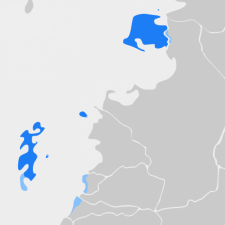Difference between revisions of "Archive:Szezk language"
m |
Protondonor (talk | contribs) m (Protondonor moved page Szezk language to Archive:Szezk language) |
(No difference)
| |
Latest revision as of 06:21, 20 October 2021
 | This article or section is out of date. A country/countries relevant to this article have been removed from Sahar and have been retconned. Not everything here may still be considered canonical. This page was last edited by Protondonor (talk | contribs) 2 years ago. (Update) |
| Szezk | |
|---|---|
| Шещка | |
| Pronunciation | [ˈɕe̞z̻ˤ:.kɜ] |
| Region | Predominantly Alcia |
| Ethnicity | Szezk Niofean Oszeteti |
| Native speakers | 34,100,000 (2017) |
| Language family | |
| Early forms: | Early Szezk
|
| Dialects | South-Avdjereg Szezk, Niofean Szezk, Ishenar Szezk |
| Writing system | Szezk Script, Szezk Braille |
| Official status | |
| Official language in | Template:Country data Alcian Union |
| Recognised minority language in | |
| Regulated by | Culture Ministry Xhovian Cultural Union |
| CWS code | sze |
 Majority
Minority | |
|
| |
Szezk (Szezk: Шещка, pronounced [ˈɕe̞z̻ˤ:.kɜ]) is a Northern Xhovian language that was first spoken in early medieval Szezkia. It is related to the other Szessic languages, particularly Niofean and Oszetet, and also to Jugian, Settian, Redesian, and Yai. The Szezk vocabulary has been somewhat influenced by Norjihani, however a large number of Norjihani loans were removed during a language reform conducted by the Szezk government, which was intended to purify the lexicon.
The Szezk language has developed from its ultimate ancestor, Proto-Xhovian, over the course of approximately 10,000 years. The earliest forms of Szezk, a collection of dialects spoken predominantly in early Norjihan and the modern-day Szezk peninsula, are called Early Szezk. The characterizing features of Middle Szezk developed during the early 11th century, around 200 years prior to the establishment of Szezk independence; it was at this time that Szezk and Norjihani's vocabularies influenced each other most. Early Modern Szezk emerged in the late 14th century, with the commercial success of the printing press, which led to the national standardization of the language, and start of the evolution of the palatalization system.
Through the influence of the Szezk navy in the Ishenar, Szezk spread to the Oszetet-inhabited island now known as the Szezk Offshore Ishenar Territory, and across the island of Niofe, as well as becoming a popular language of trade along the Isugzan coast. Today, Szezk is commonly taught as a second language, particularly in South Baredina, where it is the most widely learned second language, but also in other countries of the wider world, as it is frequently used by the region in areas of international diplomacy and finance, as well as being spread through the popularization of Szezk media and culture.
Szezk is official in five territorial entities, and in total is officially recognized in fourteen states. There are approximately as many people who have learnt Szezk as who speak it natively; it is the most commonly learned second language in Settia, Redia, Yaina, Yhael, Xhodiar and the Sjuu Federation. It is a coöfficial language of the Alcian Union and the Xhovian Cultural Union, as well as many other transnational organizations operating in South Baredina, and worldwide organizations of which the Kingdom of Szezkia is a part, including being one of the working languages of United Sahar. It is the most widely spoken Xhovian language, and has a vast vocabulary, the exact size of which is made near-impossible to determine by the nature of word compounding and the language's wide range of technical vocabulary.
Modern Szezk Grammar is the result of the gradual change typical of Northern Szessic languages, from nominative-accusative-aligned agglutinative Proto-Xhovian grammatical features to a fluid-S language with a higher frequency of fusional morphological characteristics, arising from the evolution of prepositions and particles from cases and affixes respectively. Szezk has a rich inflectional system that encodes 3 moods, 5 voices, 3 tenses, and plural and singular variations for four grammatical persons; four cases are used for nouns and pronouns (agentive, patientive, dative, genitive), and there are three lexical genders (masculine, feminine, neuter) to which adjectives and determiners decline. The future, future perfect and future pluperfect tenses are the only fundamental grammatical aspects that use auxiliary verbs. Szezk uses topic-comment word order, which typically becomes VSO in interrogative constructions and some clausal constructions that arise as a result of the language's fairly complex and flexible syntax. Despite dialectal variations in regard to phonetics and vocabulary, native speakers of Szezk from different regions are usually able to communicate with considerable ease.
Background
Phonology
Consonants
| Bilabial | Labio-dental | Dental | Alveolar | Alveolo-Palatal | Retroflex | Palatal | Velar | Uvular | Pharyngeal | Epiglottal | Glottal | |
|---|---|---|---|---|---|---|---|---|---|---|---|---|
| Nasal | m | [ɱ]1 [ɱ̥]2 | n | [ŋ̥]3 | ||||||||
| Plosive | p b | t̪ [t̚]4 d̪ d̻̥:ˤ | ȶ | k g | ||||||||
| Fricative | ||||||||||||
| Affricate | ||||||||||||
| Approximant | ||||||||||||
| Trill | ||||||||||||
| Flap or tap | ||||||||||||
| Lateral fric. | ||||||||||||
| Lateral app. | ||||||||||||
| Lateral flap |
Vowels
| Front | Near-front | Central | Near-back | Back | |
|---|---|---|---|---|---|
| Close | |||||
| Near-close | |||||
| Close-mid | |||||
| Mid | |||||
| Open-mid | |||||
| Near-open | |||||
| Open |